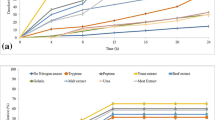Abstract
Bacteria capable of degrading the sulfonated azo dye Red HE7B were isolated from textile mill effluent contaminated soil. The most efficient isolate was identified as Bacillus sp. Azo1 and the isolate could successfully decolorize up to 89 % of the dye. The decolorized cultural extract analyzed by HPLC confirmed degradation. Enzymatic analysis showed twofold and fourfold increase in the activity of azoreductase and laccase enzymes, respectively, indicating involvement of both reductive and oxidative enzymes in biodegradation of Red HE7B. Degraded products which were identified by GC/MS analysis included various metabolites like 8-nitroso 1-naphthol, 2-diazonium naphthalene. Mono azo dye intermediate was initially generated from the parent molecule. This mono azo dye was further degraded by the organism, into additional products, depending on the site of cleavage of R–N=N–R molecule. Based on the degradation products identified, three different pathways have been proposed. The mechanism of degradation in two of these pathways is different from that of the previously reported pathway for azo dye degradation. This is the first report of a microbial isolate following multiple pathways for azo dye degradation. Azo dye Red HE7B was observed to be phytotoxic, leading to decrease in root development, shoot length and seedling fresh weight. However, after biotreatment the resulting degradation products were non-phytotoxic.





Similar content being viewed by others
References
Chen H (2006) Recent advances in azo dye degrading enzyme research. Curr Protein Pept Sci 7:101–111
Chen H, Hopper SL, Cerniglia CE (2005) Biochemical and molecular characterization of an azoreductase from Staphylococcus aureus, a tetrameric NADPH-dependent flavoprotein. Microbiology 151:1433–1441
Chen KC, Wua JY, Huang CC, Liang YM, Hwang SCJ (2003) Decolorization of azo dye using PVA-immobilized microorganisms. J Biotechnol 101:241–252
Dawkar VV, Jadhav UU, Ghodake GS, Govindwar SP (2009) Effect of inducers on the decolorization and biodegradation of textile azo dye navy blue 2GL by Bacillus sp. VUS. Biodegradation 20:777–787
Dhanve RS, Shedbalkar UU, Jadhav JP (2008) Biodegradation of diazo reactive dye navy blue HE2R (Reactive blue 172) by an isolated Exiguobacterium sp. RD3. Biotechnol Bioprocess Eng 13:53–60
Ghodake GS, Kalme SD, Jadhav JP, Govindwar SP (2009) Purification and partial characterization of lignin peroxidase from Acinetobacter calcoaceticus NCIM 2890 and its application in decolorization of textile dyes. Appl Biochem Biotechnol 152:6–14
Goszczynski S, Paszczynski A, Grigsby MBP, Crawford RL, Crawford DL (1994) New pathway for degradation of sulfonated azo dyes by microbial peroxidases of Phanerochaete chrysosporium and Streptomyces chromofuscus. J Bacteriol 176:1339–1347
Gottlieb A, Shaw C, Smith A, Wheatley A, Forsythe S (2003) The toxicity of textile reactive azo dyes after hydrolysis and decolourization. J Biotechnol 101:49–56
Hatvani N, Mecs I (2001) Production of laccase and manganese peroxidase by Lentinus edodes on malt containing by-products of the brewing process. Process Biochem 37:491–496
Kalme SD, Parshetti GK, Jadhav SU, Govindwar SP (2006) Biodegradation of benzidine based dye direct blue-6 by Pseudomonas desmolyticum NCIM 2112. Bioresour Technol 98:1405–1410
Kalyani DC, Telke AA, Dhanve RS, Jadhav JP (2009) Ecofriendly biodegradation and detoxification of reactive red 2 textile dye by newly isolated Pseudomonas sp. SUK1. J Hazard Mater 163:735–742
Kodam KM, Soojhawon I, Lokhande PD, Gawai KR (2005) Microbial decolorization of reactive azo dyes under aerobic conditions. World J Microbiol Biotechnol 21:367–370
Lowry OH, Rosebrough NJ, Farr AL, Randal RJ (1951) Protein estimation with the Folin’s reagent. J Biol Chem 193:265–275
Mabrouk MEM, Yusef HH (2008) Decolorization of fast red by Bacillus subtilis HM. J Appl Sci Res 4:262–269
Molina-Guijarro JM, Perez J, Dorado JM, Guillén F, Moya R, Hernández M, Arias ME (2009) Detoxification of azo dyes by a novel pH-versatile, salt-resistant laccase from Streptomyces ipomoea. Int Microbiol 12:13–21
Parshetti G, Kalme S, Saratale G, Govindwar S (2006) Biodegradation of malachite green by Kocuria rosea MTCC 1532. Acta Chim Slov 53:492–498
Patil PS, Shedbalkar UU, Kalyani DC, Jadhav JP (2008) Biodegradation of reactive blue 59 by isolated bacterial consortium PMB11. J Ind Microbiol Biotechnol 35:1181–1190
Saratale RG, Saratale GD, Chang JS, Govindwar SP (2011) Bacterial decolorization and degradation of azo dyes: a review. J Taiwan Inst Chem E 42:138–157
Seesuriyachan P, Shinji T, Ampin K, Srikarnjana K, Shuichiro M, Kenji A (2007) Metabolism of azo dyes by Lactobacillus casei TISTR 1500 and effects of various factors on decolorization. Water Res 41:985–992
Spadarry JT, Isebelle L, Renganathan V (1994) Hydroxyl radical mediated degradation of azo dyes: evidence for benzene generation. Environ Sci Technol 28:1389–1393
Talarposhti MA, Donnelly T, Anderson GK (2001) Colour removal from a simulated dye wastewater using a two-phase anaerobic packed bed reactor. Water Res 35:425–432
Telke A, Kalyani D, Jadhav J, Govindwar S (2008) Kinetics and mechanism of reactive red 141 degradation by a bacterial isolate Rhizobium radiobacter MTCC 8161. Acta Chim Slov 55:320–329
Yemashova NA, Kotova IBA, Netrusov I, Kalyuzhnyi SV (2009) Special traits of decomposition of azo dyes by anaerobic microbial communities. Appl Biochem Microbiol 45:176–181
Zhang D-C, Wang H-X, Liu H-C, Dong X-Z, Zhou P-J (2006) Flavobacterium glaciei sp. nov. a novel psychrophilic bacterium isolated from the China No. 1 glacier. Int J Sys Evol Microbiol 56:2921–2925
Zimmermann T, Kulla HG, Leisinger T (1982) Properties of purified orange II azoreductase, the enzyme initiating azo dye degradation by Pseudomonas KF46. Eur J Biochem 129:197–203
Acknowledgments
First author is thankful to Indian Agricultural Research Institute, New Delhi, for providing the infrastructure facilities and Council of Scientific and Industrial Research, New Delhi, for providing financial support in the form of fellowship.
Author information
Authors and Affiliations
Corresponding author
Electronic supplementary material
Below is the link to the electronic supplementary material.
Rights and permissions
About this article
Cite this article
Thakur, J.K., Paul, S., Dureja, P. et al. Degradation of Sulphonated Azo Dye Red HE7B by Bacillus sp. and Elucidation of Degradative Pathways. Curr Microbiol 69, 183–191 (2014). https://doi.org/10.1007/s00284-014-0571-2
Received:
Accepted:
Published:
Issue Date:
DOI: https://doi.org/10.1007/s00284-014-0571-2




